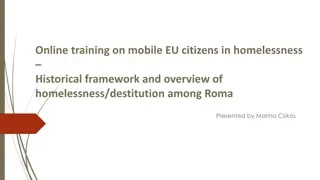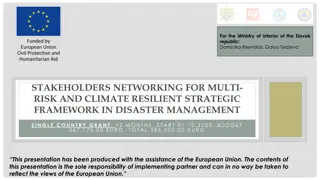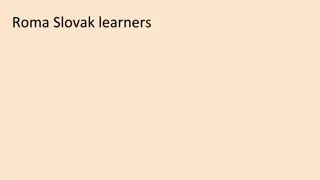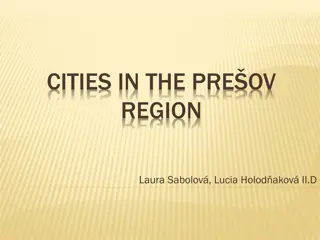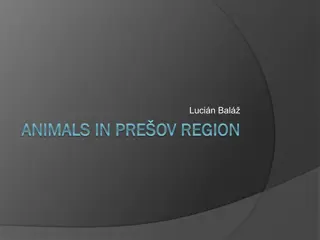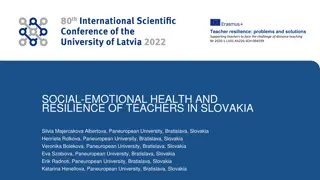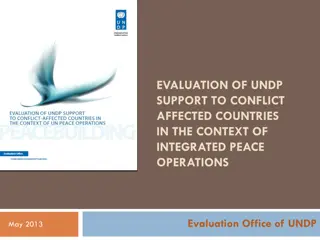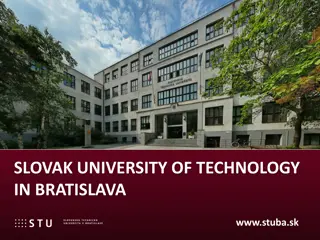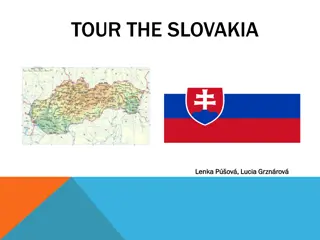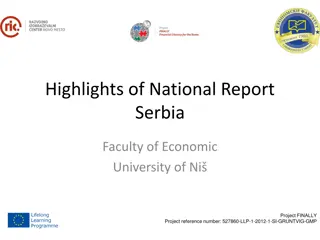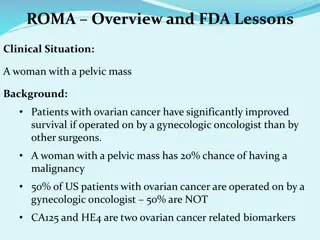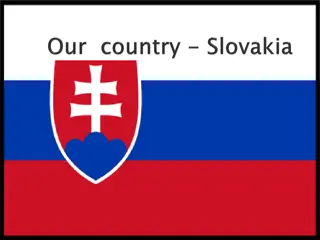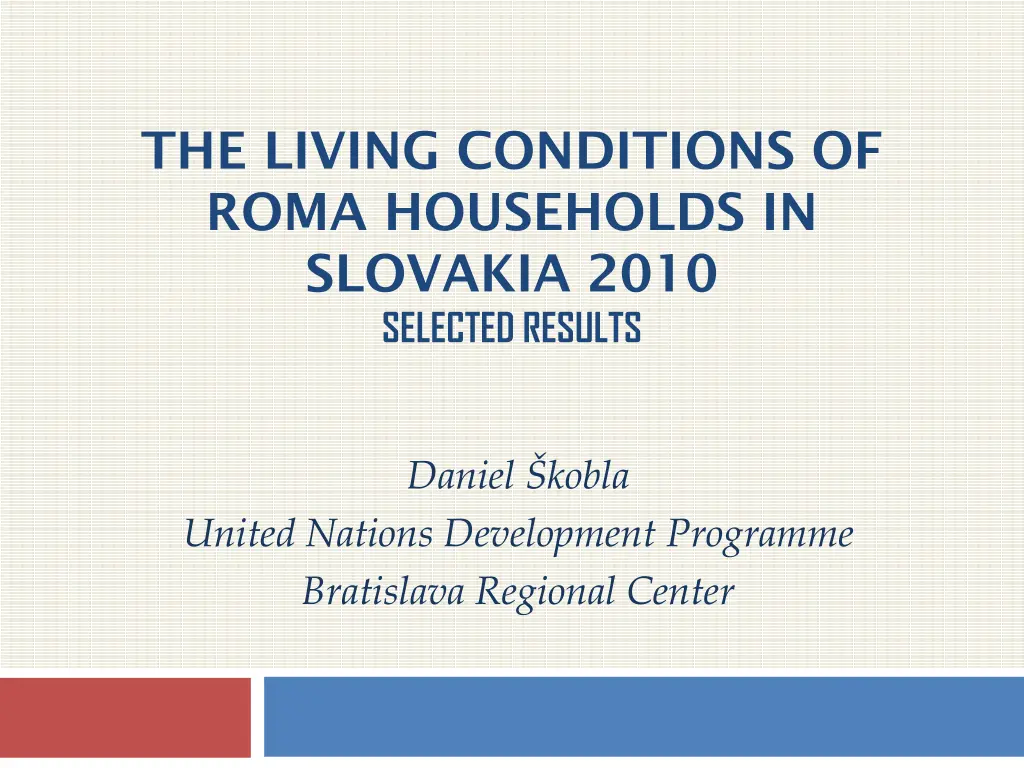
Living Conditions of Roma Households in Slovakia 2010 Insights
Explore the findings of the living conditions of Roma households in Slovakia in 2010, as researched and documented by the United Nations Development Programme. The study delves into various aspects such as the selection process, sampling framework, and field methodology used in gathering data. Gain valuable insights into the living situations of Roma communities in Slovakia during this period.
Download Presentation

Please find below an Image/Link to download the presentation.
The content on the website is provided AS IS for your information and personal use only. It may not be sold, licensed, or shared on other websites without obtaining consent from the author. If you encounter any issues during the download, it is possible that the publisher has removed the file from their server.
You are allowed to download the files provided on this website for personal or commercial use, subject to the condition that they are used lawfully. All files are the property of their respective owners.
The content on the website is provided AS IS for your information and personal use only. It may not be sold, licensed, or shared on other websites without obtaining consent from the author.
E N D
Presentation Transcript
THE LIVING CONDITIONS OF ROMA HOUSEHOLDS IN SLOVAKIA 2010 SELECTED RESULTS Daniel kobla United Nations Development Programme Bratislava Regional Center
The living conditions of Roma households 2010 Conducted by the UNDP in 2010 in cooperation with the MoLSAF SR SK (in 2005 in cooperation with the SB); The framework for the selection of locations for data collection was based on the Sociographic Mapping of Roma Communities in Slovakia (1,068 municipalities and 1,573 Roma settlements throughout Slovakia ); Roma settlements in three basic classes according to the level of integration with the majority population (segregated, separated, scattered); Locations for data collection were created in order to comprise approximately between 40 to 120 households in the same amount for each class; Through the proportional method of selection 30 data collection locations were selected for each class and 8 households were selected for each location.
The living conditions of Roma households 2010 The general population sample played the role of control group in this research; 90 primary data collection locations sampling units (PSU) were selected from the general population within the framework of neighboring municipalities in which there were Roma PSU; General PSU were classified as urban (population over 5,000) and rural (population under 5,000) and 45 districts were randomly selected; Interviewers randomly visited households in these districts, Although certain households identified themselves as Roma, they were left in the selection sample of the general population.
Final sampling framework Type of settlement Number of Primary sampling units Number of households per PSU Total number of households Segregated 30 8 240 Separated 30 8 240 Mixed/Diffused 30 8 240 Geographically closed majority 45 8 360
Field methodology Through face-to-face interviews of researchers and respondents based on structured questionnaire; A household run by an individual or a group of people who live together in the sense that they have a common organization of management formed the analysis unit; Information on households was provided by the head of the household he/she also provided information regarding small children.
Questionnaire Questionnaire contained 8 modules. Module 1: Housing, types and quality of homes, infrastructure Module 2: Household, Language Module 3: Moving Module 4: Education Module 5: Health Module 6: Economic Activity Module 7: Living Standards income, financial difficulties, deprivation in consumption Module 8: Subjective evaluation of the situation
Economic activity Several dimensions and indicators of economic activities were monitored within the framework of research; Several captured the current situation at the time of the research, others monitored the entire working history of the respondents; Mutual relations between the individual rates of employment and unemployment were also monitored; Possible causes of the existing unfavorable situation and the consequences in terms of the social and economic situation of households were also monitored.
Composition of 15+ Roma Population according to the Declared Economic Status (in Roma population 2% 7% 5% Students Workers Unemployed Homestead parental leave Old age pensioners Disability pension Others 8% 10% 11% 2% 55%
15+ Roma Population according to the Declared Economic Status Comparison with 2005 (in %) 0 10 20 30 40 50 60 70 9 tudenti a tudentky 7 7 Pracuj ci 10 57 Nezamestnan /- 54 2005 2010 1 V dom cnosti 2 12 11 RD, MD 8 8 D chodok starobn 5 D chodok invalidn 5 1 In (vr tane O D) 2
Comparison of Employment according to LFS Methodology for Individual Groups (in %) Segregated Separated Diffused Roma Geographica lly closed general population population Total Employment according to LFS Share of workers (at least 1 hour.+) on the total of population 15+ 13 16 16 15 46 - 15-64 14 16 17 16 55 - 15-55 14 17 18 16 61 - 15-24 8 9 17 11 21 - 25-54 16 21 18 19 73 - 55-64 10 10 2 8 36 -
Comparison of Unemployment according to LSF Methodology for Individual Groups (in %) Segregated Separated Diffused Roma Geographica lly closed general population population Total Unemployment according to LFS Share of unemployed on the work force 15+ 76 72 72 73 10 - 15-64 76 72 72 73 10 - 15-55 77 73 71 74 10 - 15-24 81 77 63 74 21 - 25-54 75 71 74 73 10 - 55-64 50 63 92 69 6 -
15-64 Employment Rate (LFS) according to Level of Education (in %) Geografically closed population Roma population 80 71 70 56 60 50 40 38 40 30 30 16 20 13 10 9 0 Less then standard primary ISCED 0 Standard primary ISCED 1/2 Secondary without 'maturita' ISCED 3 Secondary with maturita + ISCED 3+
15-64 Unemployment Rate (LFS) according to Level of Education (in %) Geographically closed population Roma population 90 82 76 80 70 59 60 50 42 33 40 30 17 14 20 5 10 0 Less then standard primary ISCED 0 Standard primary ISCED 1/2 Secondary without 'maturita' ISCED 3 Secondary with maturita + ISCED 3+
Roma population according to work in activation programme and type of housing (in %) Segregated Separated Diffused Total 47 46 46 Yes 47 53 54 54 No Individuals Total 53 100 100 100 100 Q: did you ever worked in activation programme? Note: Only for individuals 18 +. No response set on missing (2,5 %).
Roma Population according to Work in Activation Programme (in %) 0 20 40 60 80 100 47 yes 5 53 no 95 Roma population Geographically closed population
Conclusion I. The situation of the Roma population in the reference year 2010 is bad in terms of economic status and in principle has not changed in comparison with the situation in 2005; The status of the Roma population on the labour market is distinctively worse than that of the general population indicating different preconditions and opportunities for Roma population in terms of employment; This could also indicate: 1) discriminatory preconditions among employers; 2) weaker dispositions of Roma labour force in relation to labour market possibilities (education, qualification, family or personality).
Conclusion II. Unemployment rate decreases as level of education increases for Roma as well as non-Roma population; Roma unemployment rate is very high even among groups with higher education, which means that the benefits of higher education for the Roma population are not as numerous as those for the non- Roma population; It can be anticipated that Roma men and women must encounter greater problems in looking for skilled work even when they have higher levels of education.
Conclusion III. The list of possible factors of the effect on (un)employment among the Roma population is wide and varies according to the actual situation and baseline preconditions; The non-discriminatory access of the Roma population to the labour market should be emphasized; This is (indirectly but significantly) related to the necessity to consider the possibility of introducing principles of temporary compensatory measures to support employment; The possibilities which could be offered by the intermediate labour market must be analysed.
Conclusion IV. Strengthening of job possibilities also outside of large towns and municipalities is necessary; Jobs in rural areas, including green jobs in agriculture and forest management, must be supported, created and maintained; The education system and qualification preconditions among the Roma population must be improved.
THANK YOU http://www.undp.sk/socialinclusion


